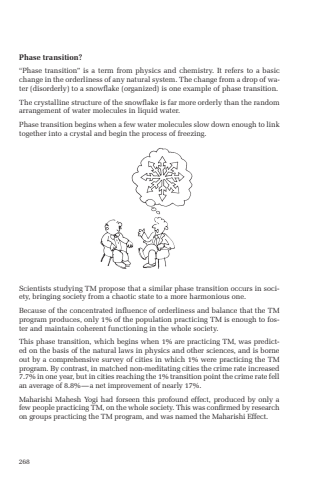Page 270 - Demo
P. 270
268Phase transition?%u201cPhase transition%u201d is a term from physics and chemistry. It refers to a basic change in the orderliness of any natural system. The change from a drop of water (disorderly) to a snowflake (organized) is one example of phase transition. The crystalline structure of the snowflake is far more orderly than the random arrangement of water molecules in liquid water. Phase transition begins when a few water molecules slow down enough to link together into a crystal and begin the process of freezing. Scientists studying TM propose that a similar phase transition occurs in society, bringing society from a chaotic state to a more harmonious one.Because of the concentrated influence of orderliness and balance that the TM program produces, only 1% of the population practicing TM is enough to foster and maintain coherent functioning in the whole society.This phase transition, which begins when 1% are practicing TM, was predicted on the basis of the natural laws in physics and other sciences, and is borne out by a comprehensive survey of cities in which 1% were practicing the TM program. By contrast, in matched non-meditating cities the crime rate increased 7.7% in one year, but in cities reaching the 1% transition point the crime rate fell an average of 8.8%%u2014a net improvement of nearly 17%.Maharishi Mahesh Yogi had forseen this profound effect, produced by only a few people practicing TM, on the whole society. This was confirmed by research on groups practicing the TM program, and was named the Maharishi Effect.


